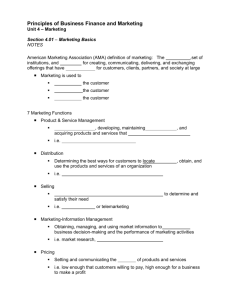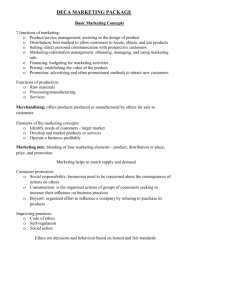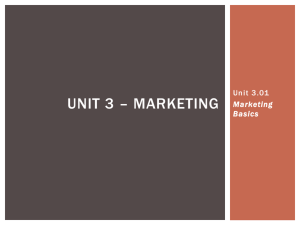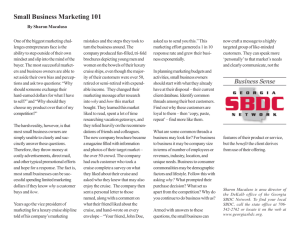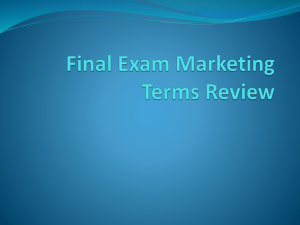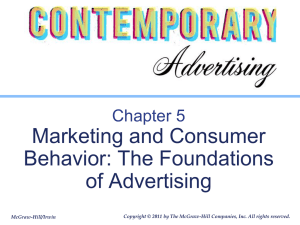Marketing - Business & Tech
advertisement
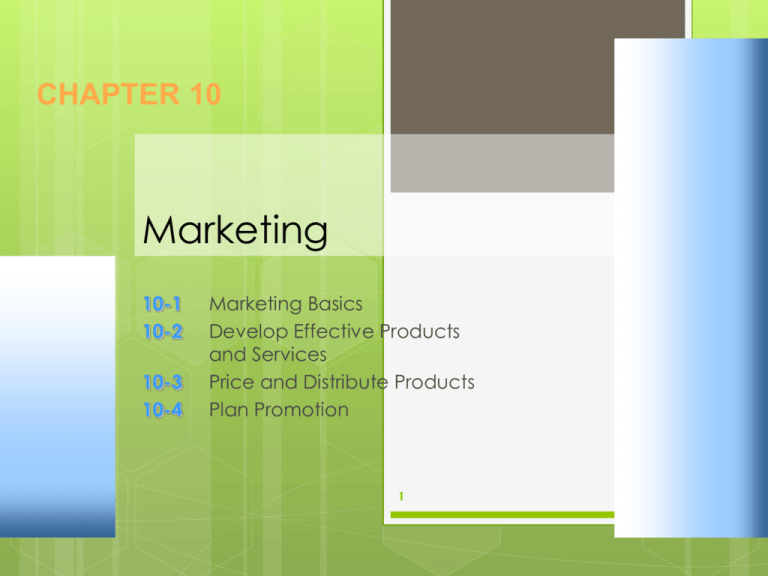
CHAPTER 10 Marketing 10-1 10-2 10-3 10-4 Marketing Basics Develop Effective Products and Services Price and Distribute Products Plan Promotion 1 10-1 Marketing Basics Goals Define important marketing concepts. Identify the steps in a marketing strategy. Describe the consumer decision-making process. • • • 2 3 Key Terms marketing marketing strategy target market marketing mix marketing orientation final consumers business consumers consumer decisionmaking process buying motives Chapter 10 4 Standards & EQ BMA-IBT-5 Demonstrate understanding of the concept of marketing and its importance to business ownership. 5.1 Explain the fundamental marketing concepts used by a small business. 5.2 Understand target market and demographics in marketing strategies. Essential Questions: What are some important marketing concepts? Chapter 10 5 Focus on Real Life Compare selling today with selling hundreds of years ago. How is it the same and how is it different? What about advertising? Most of the time businesses continue to use things that work, but must adapt to changes in consumer needs and technology. Chapter 10 6 UNDERSTAND MARKETING What People often use terms such as advertising and selling when talking about marketing. Marketing is is marketing? An organizational function and A set of processes for creating, communicating, and delivering value to customers And for managing customer relationships In ways that benefit the organization and its stakeholders. Includes a range of activities. Chapter 10 7 UNDERSTAND MARKETING Marketing activities Advertisements of the radio for products and services. You see brand names on packages you eat and wear. Interact with salespeople in stores. Read product descriptions on company’s websites All of these are examples of marketing. Chapter 10 8 UNDERSTAND MARKETING Other examples include: Storing products in warehouses. Establishing and accepting credit and arranging means of online payment. Businesses use marketing when they gather data on consumer needs. They use that info to improve products & to test new products before they are sold. Businesses market products and services Chapter 10 9 UNDERSTAND MARKETING Marketing businesses All businesses must complete some mkting activities. Includes advertising agencies and marketing research firms. Chapter 10 10 UNDERSTAND MARKETING Marketing 1. 2. 3. 4. 5. 6. 7. functions Product & Service Management Distribution Selling Marketing-information management Financial analysis Pricing Promotion Chapter 10 11 Marketing Functions Product & Service Management 1. Designing, developing, maintaining, improving, and acquiring products and services that meet consumer needs. Distribution 2. Determining the best ways for customers to locate, obtain, and use the products and services of an organization. Selling 3. Communicating directly with potential customers to determine and satisfy their need. Chapter 10 12 Marketing Functions Marketing-information management 4. Obtaining, managing, and using market information to improve business decision-making and the performance of marketing activities. Includes marketing research and development of databases with info about products, customers, & competitors. Financial analysis 5. Budgeting for marketing activities, obtaining necessary funds needed for operations, and providing financial assistance to customers so they can purchase the business’ products and services. Chapter 10 13 Marketing Functions Pricing 6. Setting and communicating the value of products and services. Customers must be able to easily to identify the price of items that interest them or they will move on to another price. Promotion 7. Communicating information about products and services to potential customers. Advertising through television, newspaper, magazines, radio, direct mail, Internet. Chapter 10 14 Marketing Functions Chapter 10 15 Checkpoint >> Define marketing and the seven marketing functions. Chapter 10 16 WTBS… Create Flash Cards Write each marketing function on one side of the card and the definition on the other side of the card. Work in teams of 2 to study the function and their definition using the flash cards 15 minutes… Chapter 10 17 MARKETING STRATEGY Marketing planning Develop a successful marketing strategy Aimed at satisfying customers needs better than competitors do, resulting in sales and profits. A company’s plan that identifies how it will use marketing to achieve it goals. Marketing Strategy (2-step process) 1. 2. Identify a target market (specific group of consumers who have similar wants and needs) Create a marketing mix (blending of four marketing elements Product Distribution Price Promotion Chapter 10 18 Developing a Successful Marketing Strategy Marketing orientation Considers the needs of customers when developing a marketing mix. Businesspeople use research to study customers and their needs. The results of the research are used to plan a marketing mix designed to satisfy those needs. Chapter 10 19 Marketing Mix Example Company owns a fleet of cruise ships gathers info on people who might consider a cruise as a vacation choice. Product Exciting, relaxing cruise experience Onboard activities, onshore activities Distribution Providing all of documents needed by travelers, arranging customer travel to & from port city, handling baggage, ensuring effective customer service throughout process. Price Provide affordable cruise with payment options to meet the budgets of target customers. Promotion Offers information to interest prospective customers in the 10 cruise and persuade them to decided it is the best Chapter vacation choice 20 Checkpoint >> What are the two steps in developing a marketing strategy? Chapter 10 WTBS… 21 On a sheet of paper, with a partner, write down a product or service. Identify the target market (write down similar needs and wants of them) Write the marketing mix for that product or service. Product Distribution Price Promotion 10 minutes… Chapter 10 22 Understand Customers Effective marketing begins with customers Many new businesses fail b/c the owners have an idea for the product, but fail to consider customers and their needs. Business can develop products for 2 types of consumers: 1. 2. Final consumer – Persons who buy products and services mostly for their own use. Business consumer - persons, companies, and organizations that buy products for the operation of a business. Chapter 10 23 UNDERSTAND CUSTOMERS Consumer decision-making 1. Recognize a need. 2. Gather information. 3. Select and evaluate alternatives. 4. Make a purchase decision. 5. Determine the effectiveness of the decision. Buying motives (reasons consumers decide what products and services to purchase) Emotional buying motives Reasons to purchase based on feelings, beliefs, and attitudes. Rational buying motives Chapter 10 Guided by facts and logics. (ex. College to attend, car to buy) 24 Checkpoint >> What are the steps in the consumer decision-making process? Chapter 10 25 WTBS… Think of something you purchase and which motive (Emotional or Rational) persuaded you to make the purchase. 3 minutes… Chapter 10
